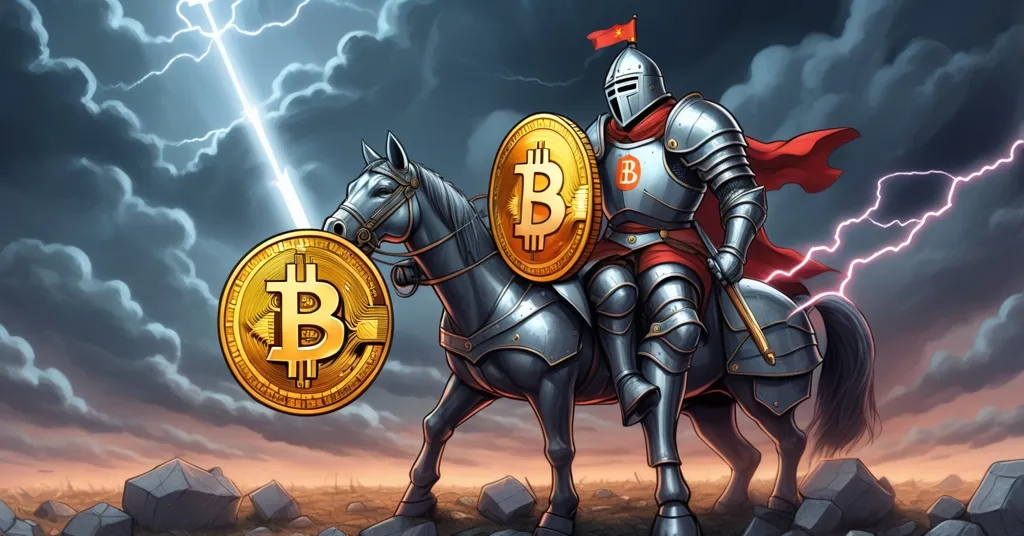Bitcoin HODLing Hits 2-Year High: Confidence or Risk Amid US-China Trade Chaos?

Bitcoin HODLing Soars to 2-Year High: Confidence Amid Global Chaos
Bitcoin is holding strong above $104,000 as on-chain data from CryptoQuant uncovers a powerful trend: HODLing levels have hit a two-year peak, reflecting unshakable confidence among long-term holders. With global economic tensions, particularly US-China trade disputes, casting shadows over markets, this surge in holder conviction could signal a supply-driven rally—or a risky bet against mounting headwinds.
- HODLing Peak: Bitcoin holders are locking away coins at the highest rate in 24 months, per CryptoQuant.
- Price Range: BTC trades at $104,892, trapped between support at $103,600 and resistance at $109,300.
- Economic Risks: US-China tariff wars add uncertainty, yet boost Bitcoin’s “digital gold” appeal.
HODLing: A Defiant Signal of Conviction
Let’s cut to the chase: Bitcoin holders are digging in their heels like never before. Data from CryptoQuant’s on-chain analysis shows that the number of Bitcoins sitting untouched in wallets—rather than flowing to exchanges for sale—has reached its highest point in two years. For the uninitiated, HODLing (a term born from a typo in early Bitcoin forums, meaning to hold your crypto no matter the market’s tantrums) is a key indicator of investor sentiment. When holders refuse to sell, it shrinks the available supply, often creating a pressure cooker for price surges if demand picks up.
Top analyst Axel Adler, sharing insights on X, underscored this trend with a critical on-chain metric:
“The Bitcoin Exchange Flows to Network Activity Ratio is highlighting a powerful on-chain signal: the current HODL level is at its highest point in the past two years.”
This ratio essentially tracks how much Bitcoin is moving to exchanges (a sign of potential selling) versus staying in private wallets (a sign of holding). Right now, the balance is tipped heavily toward holding, suggesting long-term investors are betting big on Bitcoin’s future, as noted in recent reports on Bitcoin HODLing trends hitting a 2-year high. Historically, we’ve seen this behavior before the massive rallies of 2017 and 2021, where supply squeezes fueled parabolic price jumps. Back in late 2020, for instance, similar HODLing patterns preceded Bitcoin’s climb from $10,000 to nearly $69,000 in under a year. While exact numbers for today’s HODLed supply percentage aren’t public in this dataset, the qualitative trend screams confidence. Could this be the quiet before another storm of green candles? We’ll see—but history has whispers of optimism.
Bitcoin’s Price: Flirting with Breakout or Breakdown
Zooming into the charts, Bitcoin is playing a coy game. Sitting at $104,892 on the 4-hour chart (data courtesy of TradingView), it’s squeezed in a tight range between key support at $103,600 and resistance at $109,300. For those new to trading lingo, support is a price level where buying interest often kicks in to prevent further drops, while resistance is where selling pressure tends to cap upward moves. Right now, BTC is hovering above the 200 Simple Moving Average (SMA) at $103,600—a tool traders use to spot long-term trends by averaging prices over 200 periods—which signals bullish undercurrents. Yet, the flattening 34 Exponential Moving Average (EMA) and 50 SMA hint at indecision, like a market that can’t pick a direction at a crossroads, amidst broader global economic uncertainty impacting Bitcoin prices.
A push above $106,000 could spark bullish momentum, potentially eyeing that $109,300 ceiling or beyond. But slip below $103,600, and we might see a nastier retracement, possibly testing lower supports. What’s more telling? Trading volume is eerily low during this consolidation—a classic sign of a coiled spring ready to snap. Big moves, up or down, often follow such quiet periods. So, while HODLers exude confidence, the price action is a fickle tease, waiting for a catalyst to show its hand. Keep your eyes peeled; this isn’t a market for the faint-hearted.
Economic Tensions: Bitcoin’s Threat or Tailwind?
While Bitcoin’s on-chain story is one of quiet resolve, the global stage is a damn mess. The US-China trade war has roared back to life, with tariffs piling up faster than bad decisions at a Vegas casino. Recent moves under the Trump administration include a minimum 10% tariff on US imports, with escalations on Chinese goods hitting as high as 125% by April 2025. China clapped back with a 67% tariff, the US countered with 34%, and tossed in a 25% hit on automobile imports for good measure. Global leaders, from France to Italy, have labeled this an “economic catastrophe,” and economists warn that protectionist policies could cripple supply chains. For clarity, tariffs are taxes slapped on imported goods to shield domestic industries, as detailed in this explainer on tariffs and their economic impact, but they often jack up consumer prices and ignite retaliatory trade spats—exactly what’s unfolding now.
So, where does Bitcoin fit in this quagmire? Risk assets—stocks, crypto, you name it—usually take a beating when uncertainty spikes. Yet, paradoxically, Bitcoin often shines as a hedge during such chaos. With fiat currencies at risk of inflation from disrupted trade and rising costs, a borderless, decentralized asset like BTC starts looking like a lifeboat in choppy waters, a perspective echoed in discussions on Bitcoin’s role during US-China trade tensions. The HODLing surge backs this narrative: holders aren’t cashing out; they’re doubling down on Bitcoin as “digital gold.” There’s even a small silver lining—tech products like smartphones and chips are exempt from these tariffs, which could stabilize tech markets and indirectly fuel risk-on sentiment in crypto. But don’t pop the champagne yet. If trade tensions trigger a broader financial meltdown or inflation spirals, even Bitcoin might not escape the fallout unscathed.
Risks to HODLer Resolve: Not All Roses
Before we get too cozy with this HODLing optimism, let’s play devil’s advocate. Sure, long-term holders locking away their Bitcoin paints a bullish picture, but it’s not a bulletproof strategy. What if this isn’t confidence, but paralysis? Some investors might be clinging to past losses, trapped in a sunk-cost mindset rather than a visionary one. Then there’s the external gut punches: governments could swing a regulatory sledgehammer overnight, banning exchanges or taxing crypto into oblivion. A full-blown bond market crash or margin calls on over-leveraged whales—big players holding massive BTC stashes—could force liquidation, flooding the market with supply no matter how steely the HODLer resolve, a concern raised in community discussions on Reddit about Bitcoin HODLing surges.
Even history, while kind to HODLers in past cycles, isn’t a crystal ball. During the 2018-2019 trade war flare-ups, Bitcoin initially dipped before rebounding as a hedge narrative took hold. But today’s macro setup, with higher stakes and crazier debt levels, might not play out the same. HODLing signals strength, no doubt, but it’s a gamble against forces way bigger than any blockchain. If you’re expecting a guaranteed moonshot, wake up—this market eats blind faith for breakfast.
Beyond Bitcoin: Blockchain’s Broader Fight
Bitcoin might be the poster child of decentralization, but the broader blockchain space is quietly gearing up to tackle real-world messes like trade disruptions. Platforms built on Ethereum and other protocols are forging tools for supply chain transparency—think tracking a product’s journey from factory to shelf to dodge tariff-driven chaos. Projects like IBM’s Food Trust or VeChain use blockchain to verify goods’ origins, cutting through fraud and inefficiencies that explode during trade wars, with some analyses highlighting blockchain’s potential to mitigate trade war disruptions. For newbies, blockchain is the tech underpinning crypto: a decentralized ledger that records transactions across a network, making tampering damn near impossible.
While Bitcoin remains king as a store of value—a digital fortress against fiat failures—Ethereum’s smart contracts (self-executing agreements coded on the blockchain) are carving niches BTC doesn’t touch. These innovations don’t directly spike Bitcoin’s price, but they reinforce the ethos of decentralization, proving this revolution isn’t just about one coin. It’s about flipping broken systems on their head. As HODLers bet on Bitcoin’s staying power, the wider crypto ecosystem is building life rafts for a tariff-torn economy. That’s the kind of disruption we’re here for.
Key Takeaways and Questions on Bitcoin’s HODLing Surge
- What’s behind Bitcoin HODLing reaching a 2-year high?
CryptoQuant data shows long-term holders refusing to sell, likely trusting Bitcoin as a safe haven amid economic uncertainty like US-China trade wars. - How do trade tensions affect Bitcoin’s outlook?
Escalating tariffs fuel market uncertainty, pressuring risk assets like BTC, but they also amplify its appeal as a hedge against inflation and fiat weakness. - Is HODLing a surefire path to a Bitcoin rally?
No—while reduced supply often sparks price jumps, risks like regulatory crackdowns or market crashes could force selling, derailing the trend. - What price levels are critical for Bitcoin right now?
Watch support at $103,600 and resistance at $109,300; a break above $106,000 could signal bullish momentum, while a drop below risks deeper losses. - Can blockchain tech address trade war fallout beyond Bitcoin?
Absolutely—Ethereum-based projects and others are creating supply chain transparency tools to track goods, easing disruptions caused by tariffs and inefficiencies.
Bitcoin’s current saga is a gritty showdown between on-chain defiance and global disorder. HODLers are planting their flag, betting on BTC’s resilience as a middle finger to a teetering financial system. But with trade wars raging and macro landmines everywhere, conviction alone might not be enough. Are these holders the vanguard of a monetary uprising, or just stubborn players ignoring a looming bust? Only the market—and time—will deliver the verdict. One thing’s clear: in a world of centralized blunders, decentralization remains the ultimate rebellion. Let’s see if it holds the line.



